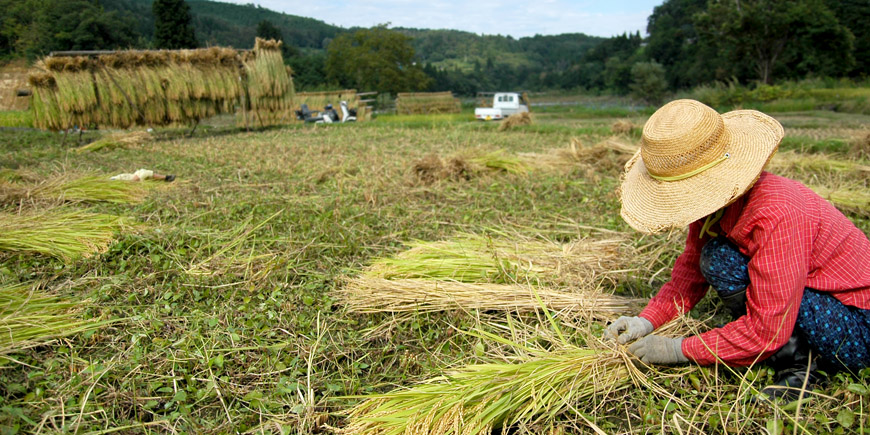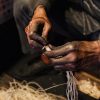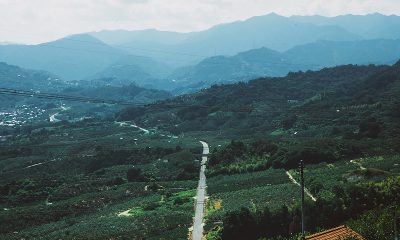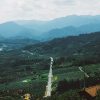Featured
Bringing in the harvest
Rice is the staple dish of Japanese cuisine, but how exactly does it get from the field to your bowl? KS gets down in the dirt to harvest rice in Nagano Prefecture.
The sound of running water permeates my dreams. I assume it is the rain Kevin predicted the night before, but when I slide open the shoji-covered window the ground is dry. The sound comes instead from the narrow canals lining the village roads. A never-ending stream of water pours down from the nearby mountains, tumbling to the river carving its way along the valley floor. The sky is overcast, but so far no rain. We can work today after all. I am so excited I practically jump out of my pajamas into my farm clothes.
My husband and I arrived the evening before, traveling by shinkansen to Echigo-yazawa. There we boarded a small local bus that carried us past ski resorts preparing for winter, up into mountains where leaves hinted at autumn color. We are headed to a tiny village where Kevin will add us and our luggage to the supplies he’s picked up. Then we’ll head to Sakae-mura, an even smaller village deeper in the mountains where we will help harvest his rice.
Four years ago on our first trip with One Life Japan, the outdoor adventure company run by Kevin Cameron and Tomoe Kawafuchi, we helped rethatch a traditional farmhouse and prepared their rice fields for planting. We’d stayed in touch, following Kevin and Tomoe’s rural adventures online. His fantastic photos and their delicious rice (available via the website) made this trip a mouth-watering prospect.
Kevin and Tomoe started One Life Japan when they moved to Sakaemura six years ago from Tokyo. They wanted out of the city, to farm and live a more sustainable life. One Life is a way to share their discoveries and help visitors explore another side of Japan. Tours center around hiking, biking and farming with plenty of good food at every turn. Tomoe’s goal is to learn as much as she can about the traditional practices—from field to table—in the region. “There’s such a beautiful food culture here,” she says while telling me about a new recipe.
Based on the simple, seasonal food we eat it’s clear Tomoe is an excellent student. Her artisanal breads enjoy increasing popularity at local shops and the Nagano farmers market. The bread is a centerpiece of our breakfasts, its rice flour base and whole grains making it chewy and flavorful. We decline butter and jam, and eat it plain. It’s that good.
After breakfast we head to the field where Kevin demonstrates how to use the small kuma (scythe) to cut the rice stalks. Two mothers and their sons arrived from Tokyo that morning, and we all watch Kevin crouch low among the yellowed stems heavy with grains. Each clump of plants is cut with a single motion, gathered into bundles and laid in pairs behind him, their bases crossed in preparation for tying.
We work along on our knees or crouched next to the plants. Even though the tanbo (rice field) was drained weeks ago, the ground remains damp, leaving wet spots on our trousers. The leaves of the rice plants, gold and green, brush on sleeves and hats. Thick weeds along the aze (ridges between fields) lean in, making the harvest more difficult at times. Small frogs leap before us, one venturing up a sleeve resulting in a ruckus followed by gales of laughter. Our chatter gradually fades into birdsong and the rhythm of the harvest. At some point Tomoe arrives with a thermos of tea and a pan of just-out-of-the-oven apple bread. We sit on the edge of the field eating and soaking up the country quiet.
When the cutting finishes we learn to tie the paired bundles together and hang them. Three or four strands of last year’s wara (rice straw) get wrapped a few inches below the cut stems and then twisted together. “Make sure it wraps tightly in that first go-round before you begin twisting,” Kevin advises. “Otherwise, the bundle is too loose and will fall apart while it hangs.” Brows furrowed in concentration we carefully twist and maneuver the bundles in a field now covered with stubble and scattered pairs of rice plants. When the twisted wara curls in on itself, it is ready to be tucked under the band made by the first wrapping. The two bundles are splayed and hung on the rack, a multi-level structure of poles and cross-bars set up at the end of the field. They will stay here for about a week to dry.
Dusty, dirty and already a little sore we head to the local onsen, a small affair in a simple one-story building. Local residents take advantage of the piping hot mineral water for their daily bath and as a place to chat and gossip. We emerge fresh and clean, and pile into the van for Keiko Sugihara’s 120-year-old farmhouse where we will spend the night. Snug against the mountains with a small stream just outside her door and surrounded by her rice and vegetable fields, her home is a cozy resting spot. The smell of fresh cooked rice greets our group as we enter the first floor room. Tempuracoated seasonal vegetables, homemade pickles like zuicki (pickled tarot stem), mazegohan (cooked rice mixed with carrot, bamboo, and mushroom), miso soup, and an assortment of other little tidbits are arrayed before us. We feast and talk until our cups of tea are empty and the plate of fresh fruit – kaki (persimmon) and apples – is gone. One by one we drift off to bed, to dream of golden rice hanging in the sun and steaming in our bowls.
How to get out on the farm
One Life Japan
Roam the mountains and countryside of Nagano for extraordinary views, good food, and great fun.
onelifejapan.com
Satoyama Experienc
Explore the rural areas of Gifu’s Hida region by bicycle or on foot for a taste of Japan’s beautiful countryside.
satoyama-aexperience.com
WWOOF Japan
Connect with organic growers and producers all over Japan for an unforgettable hands-on experience.
wwoofjapan.com













